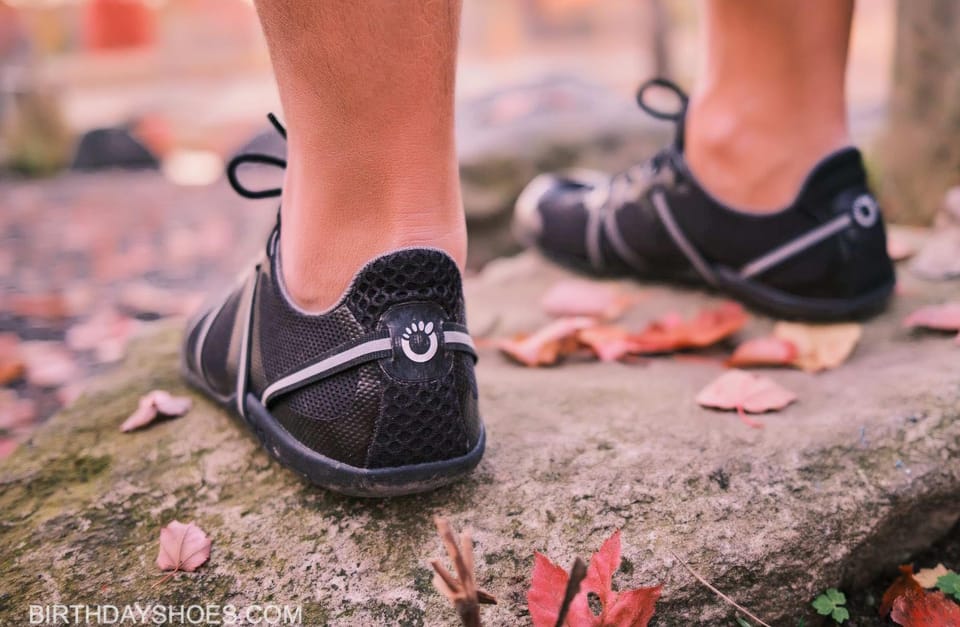Barefoot Running Shoes
Barefoot Running Shoes aren't an oxymoron. What else could you call minimalist footwear that mimicks the biomechanics of barefoot running? We define barefoot running shoes by weight, flexibility, style, and more!
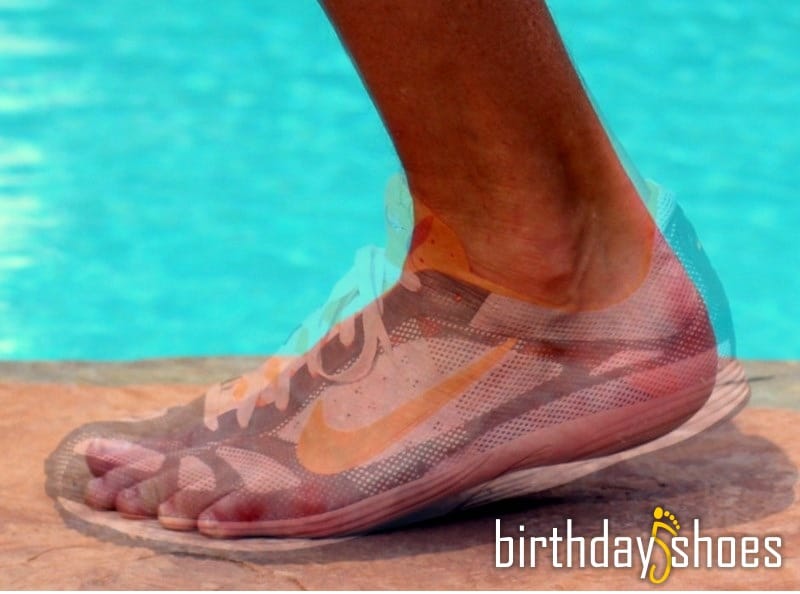
Barefoot running shoes have become all the rage as the advantages of barefoot running have become widely known, but what the heck is a barefoot running shoe? While we might immediately think "barefoot" and "shoe" couldn't possibly coexist together, internet searches for this oxymoronic combination of words have taken off in the last year:
What are these "barefoot running shoes" that everyone is searching for? Sifting through the search results I see a lot of Vibram related links, but also links to Huaraches and Nike Frees. I thought it would be interesting to see where all of these different shoes fall on a "barefoot running shoe" continuum.
What continuum you ask? Read on!
Evaluating Barefoot Running Shoes
There are a lot of ways to define, evaluate, and categorize "barefoot running shoes". Here is a partial list:
- Shoe Design
- Heel to toe drop
- Roominess of the toe box
- Thickness of the midsole
- Overall Weight
- Minimal Arch Support
- Shape of the shoe and sole(last)
- Durability and Workmanship
- Feel for the Road
- other criteria...
Barefoot Running Shoes Ranking Critieria
So, finding the best "barefoot running shoe" for any individual involves examining lots of criteria, but which criteria make them more or less barefoot? Here are the criteria I have chosen to evaluate a shoe's barefootedness and why:
1. Barefoot Running Shoe Type
A flexible, thin-soled, toe shoe that is shaped like a foot is more barefoot-like than an inflexible traditional running shoe with a thick midsole. A thinner, flexible sole puts your foot closer to the ground, has a better road feel and is more barefoot-like. Thicker soles put you farther away from the ground giving a cushioned marshmallow feel. While there are some overlapping features, I have attempted to categorize the "barefoot running shoes" I often hear mentioned on the internet into one of the following four categories that I listed here from most to least barefoot:
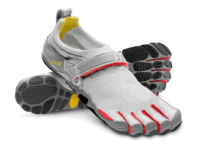
Toe Shoes —
e.g. Five Fingers, Inov-8 Evo Skin
- very flexible
- thin soles
- foot shaped
- toe compartments
I listed "toe shoes" first because of their great barefoot feel and function (The toe pockets do a great deal to keep the shoes moving dynamically with your foot). The thin and flexible soles give an excellent ground feel and the addition of toe pockets puts them at the top of the list. I can move, flex, grip and feel with my toes in all of my Vibrams. Though not truly barefoot, they are the closest thing I can imagine to barefoot while allowing me to do things I could never do with unprotected feet.
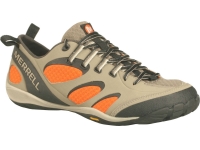
Foot Friendly —
e.g. huaraches, mocs, Vivo Barefoot Evos, Feelmax, Merrell Barefoot, New Balance Minimus, etc.
- very flexible
- thin soles
- foot shaped
- no toe compartments
- roomy toe box
The group I am dubbing "foot friendly" includes two distinct types of shoes, shoes based on timeless designs like moccasins (a la Soft Star Shoes) and huaraches (a la the Tarahumara Indian's shoe of choice as read about in Born to Run) and a new type of barefoot, minimal shoe like those made presently by Terra Plana (see the Terra Plana Vivo Barefoot Evo review) and Feelmax. These new-tech barefoot running shoes are low to the ground and have very thin soles, providing excellent road feel in a more traditional shoe package. Given the surge in demand for barefoot running shoes, the upcoming releases from Merrell Barefoot as well as the New Balance Minimus should be very telling about the future of this sector. Barefoot running shoes sans individual toes may be the best of both worlds for those who don't like the attention that toe shoes bring.
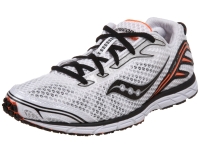
Flats —
e.g. minimal racing flats, trail running shoes, retro running shoes
- flexible
- medium soles
- traditional shoe shaped
The third group I call "flats", since many of the shoes I have included are racing flats and trail running shoes. These shoes have increasingly become lighter with less elevated heels over the last couple of years with the emergence of the forefoot strike running style. The big difference between "flats and "foot friendly" is the sole. While flats have much lower profile midsoles than traditional running shoes, they are still thicker than the shoes in the "foot friendly" group. I really like this type shoe and do most of my running in flats. I get more protection from the elements while retaining some ground feel and am able to maintain a forefoot strike.
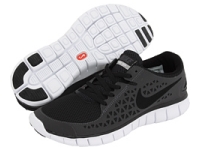
Wherefoot —
e.g. bulky, neutral (or close-to-neutral) running shoes with thickly padded soles
- bulky
- flexible
- thick soles
- traditional shoe shaped
I call the final category of barefoot running shoes "Wherefoot". While these shoes are neutral (or close to neutral) and allow runners to maintain a forefoot strike, the barefoot ground feel is lost by having too thick of a sole or being a bit bulky. However, shoes in this category are often marketed as being barefoot. It is hard to see how something a full 20mm off the ground can be considered barefoot. They seem to be the opposite. Ground feel is replaced by a cushioned, marshmallow feel. The good thing about these shoes is that they have less elevated heels than most traditional running shoes which makes it easier to run with a healthy forefoot strike. So, if you are not concerned about a "barefoot" ground feel these shoes may be a viable option for forefoot strike, good form running. Nike Frees are probably the quintessential, most popular "wherefoot" shoes.
Specific, additional criteria for ranking barefoot running shoes:
2. Drop
One of the most important and most mentioned benefits to barefoot running is maintaining a forefoot or midfoot strike while running. The less a shoe drops from heel to forefoot, the easier it is to run barefoot-like. I have broken drop out like this:
- Zero - 0mm
- Low - up to 6mm
3. Weight
The less a shoe weighs, the closer you are to being barefoot, yet, less weight can mean less protection and durability. So, even though lighter is more barefoot-like, a shoe should be chosen to provide the amount of protection and durability you expect.
- Ultra Light - up to 6 oz.
- Light - greater than 6 oz. but not more than 12 oz.
So, without further ado...I present to you the Barefoot Running Shoes Continuum to gauge different levels of barefoot goodness. It is sorted by shoe type, then drop, then weight.
Barefoot Running Shoes
| |||
Type |
Drop |
Weight |
Barefoot Running Shoe |
|---|---|---|---|
| Toe Shoes | Zero | Ultra LightVibram Five Fingers Classic Vibram Five Fingers Sprint Vibram Five Fingers KSO Vibram Five Fingers KSO Trek Inov-8 EvoSkin* | |
| LightVibram Five Fingers Bikila Vibram Five Fingers Trek Sport Vibram Five Fingers Bikila LS* | |||
| Foot Friendly | Zero | Ultra LightLuna Sandal (huaraches) Invisible Shoe (huaraches) Altra Adam* Soft Star RunAmoc Feelmax Osma | |
| LightTerra Plana Evo Merrell Barefoot True Glove* Merrell Barefoot Trail Glove* Inov-8 Road-X* Inov-8 Bare Grip 200* | |||
| Low | LightNew Balance Minimus Road* New Balance Minimus Trail* | ||
| Flats | Zero | LightGoLite Tara Lite Altra Instinct* | |
| Low | Ultra LightAsics Piranha SP3 Brooks Mach 12 Spikeless Mizuno Wave Universe 3** | ||
| LightSaucony Grid Type A4 Asics Gel Hyperspeed 4 Adidas AdiZero Rocket Puma Complete RoadRacer 4 Saucony Kinvara Inov-8 F-Lite 195 Inov-8 X Talon 190 | |||
| Wherefoot | Zero | LightGoLite Flash Lite GoLite Amp Lite | |
| Low | Ultra LightNike Zoom Streak XC 2 | ||
| LightNike Free 3.0 V2 Nike Lunaracer Newton Gravity Newton Distancia S | |||
| *announced but not yet available **possibly lower drop than advertised | |||
What didn't make the cut
I have made an effort to exclude any shoes with a drop of greater than 6mm and a weight over 12 ounces. However, the statistics are not always easy to ascertain and I may have made some mistakes. Feel free to correct me or suggest additions to the list.
I left out track shoe type racing flats like the Saucony Kilkenny XC-3 and the Nike Zoom Waffle Racer VII although some minimalist run in them. They often have receptacles for spikes, are narrow and have rigid soles under the forefoot.
Conclusion
While this continuum just scratches the surface of finding the best barefoot running shoe for any individual, hopefully, it weeds out which shoes should even be considered and gives some perspective on how close they are to being barefoot. In the end, any shoe may really suck. Each shoe needs to be examined, reviewed and tested to make an accurate assessment. Armed with this information, barefoot runners can make an educated guess whether a specific shoe will work for them.
I enjoy running in Vibram Five Fingers because they closely approximate a barefoot feel and force me to improve my forefoot strike form. But, I don't run in them all of the time. I alternate shoes, running in minimal racing flats for long runs and Vibrams for shorter runs. There are many minimal running shoes that work well for forefoot strike runners, and though most folks would not consider them "barefoot running shoes", they can provide added protection while also helping avoid the injuries associated with heel striking. Perhaps, Christopher McDougall said it best:
But ultimately, the debate isn't about Bare Soles vs. Shoes. It's about learning to run gently. Master that, and you can wear — or not wear — anything you please. Christopher McDougall, author of Born to Run
Hopefully, this continuum is helpful for comparing the relative barefootedness of various running shoes. Again, please comment and feel free to suggest changes or additions to the list.
Vote for a barefoot running shoe in the poll located in the right sidebar!
H/T to Pete Larson at runblogger.com who's research on minimalist running shoes helped immensely in compiling my list.

